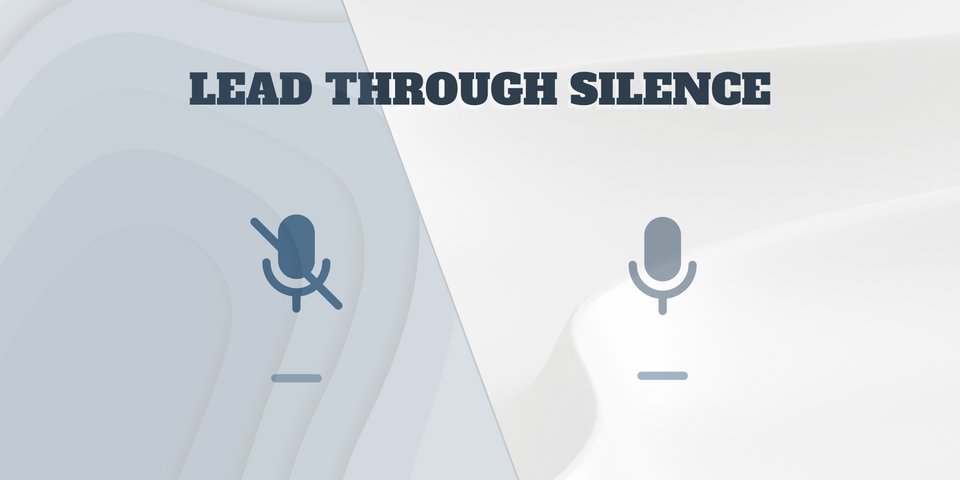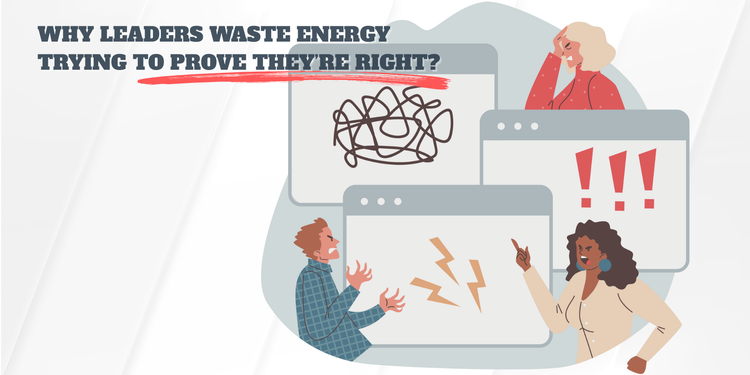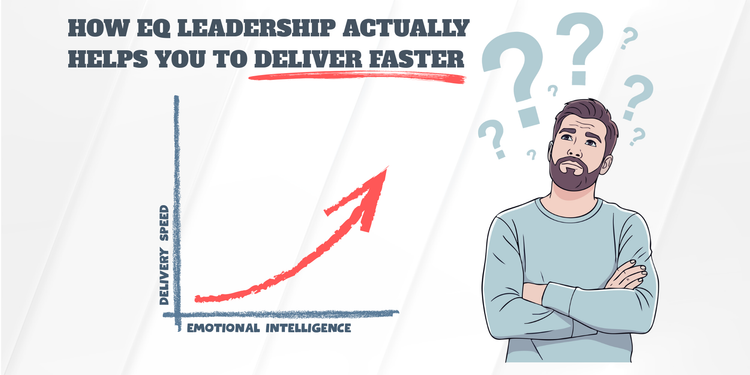How to Lead Through Silence

Silence is one of the most misunderstood signals in leadership.
You present an idea in a meeting… and no one responds.
You ask for feedback… and the room stays quiet.
You raise a tough topic… and people look down at their notes.
For many leaders, silence feels like failure. The instinct is to fill it quickly – with more words, more data, more reassurance, or a rushed decision just to break the tension. But silence isn’t empty. It’s full of meaning.
The problem is that meaning changes depending on the context:
- Sometimes silence means people disagree but don’t feel safe saying it.
- Sometimes it means they’re still processing and need more time.
- Sometimes it signals quiet agreement – nothing more to add.
- And sometimes it signals withdrawal – people are disengaged altogether.
When leaders don’t know how to read silence, they misinterpret it. They assume alignment when there’s resistance. They interpret processing as disengagement. They miss the signs of withdrawal until it’s too late.
EQ leaders approach silence differently. They don’t rush to fill it. They hold it, read it, and invite the right kind of dialogue. They understand that what isn’t said can be just as important as what is.
Silence isn’t a void – it’s a signal. The question is: are you listening?
Why Silence Matters in Leadership
Silence is never just silence. It’s communication in its own right. The problem is, most leaders don’t know how to interpret it.
In fast-paced environments, silence can feel like wasted time. Leaders feel pressure to move fast, to keep energy high, to fill every pause with decisions or explanations. But when you rush to fill silence, you miss what it’s really telling you. And silence always tells you something.
The Risks of Misreading Silence
- Mistaking silence for agreement
You present a new strategy, no one pushes back, and you assume everyone is aligned. But later, resistance surfaces in passive ways – missed deadlines, lack of enthusiasm, or “silent vetoes” where people slow-walk the work. The project doesn’t stumble because of the strategy itself, but because the quiet resistance was never surfaced. - Confusing processing with disengagement
Some topics require space. When you drop complex information into a room, people often need time to process. But if you interpret their quiet as disinterest, you may speed up, oversimplify, or even change direction prematurely. In reality, they weren’t disengaged – they were thinking. - Overlooking withdrawal
Withdrawal is the most dangerous form of silence. Someone who used to contribute actively is suddenly quiet. You may interpret it as focus, but what’s really happening is disengagement – loss of motivation, lack of psychological safety, or quiet burnout. By the time you notice it, it’s often much harder to repair. - Forgetting cultural and personality differences
Silence doesn’t mean the same thing for everyone. In some cultures, silence is respect. For introverts, silence can mean deep thought. For others, silence may mean discomfort or fear. If you assume silence has only one meaning, you miss these nuances.
Why Silence Is So Uncomfortable for Leaders
Silence feels ambiguous. And ambiguity makes leaders feel out of control. Without feedback or reaction, you’re left to guess: Do they agree? Are they resisting? Are they lost? That uncertainty is why many leaders rush to fill silence with more talking.
But here’s the truth: silence is data. It’s just harder to read than words. If you treat it as absence, you’ll miss crucial signals. If you treat it as information, you unlock a new level of insight into how your team is really experiencing the moment.
What EQ Leaders Do Differently
Emotionally intelligent leaders don’t fear silence – they use it. They hold the pause without panicking. They read the signals around the silence: body language, eye contact, posture, energy. And most importantly, they ask into the silence instead of assuming.
- “I notice it’s quiet – are we aligned, or are there concerns we haven’t surfaced?”
- “Take a moment to think this through. I’ll pause so you can process.”
- “I want to check – is the quiet here agreement, or hesitation?”
By naming the silence, they normalize it. By inviting dialogue, they turn silence into clarity. And by holding the space, they build psychological safety.
Silence isn’t empty. It’s full of signals. Leaders who can interpret those signals gain access to the truth of the room – while others are left guessing.
A Personal Story
I’ll never forget one particular meeting early in my leadership journey.
I had just presented what I thought was a strong idea for improving one of our delivery processes. I laid out the reasoning, the benefits, even some initial steps. Then I looked around the room… and nothing. No questions. No comments. Just silence.
I panicked inside.
The silence felt like rejection. My mind raced: “They hate it. I’ve missed something. I need to keep talking until I convince them.” So I filled the air with more data, more justifications, more words.
The meeting ended with polite nods – but the energy was flat. A week later, I found out several people didn’t agree with my proposal at all. They just hadn’t felt comfortable speaking up in the moment. What I had read as “agreement” was really “resistance.”
That was a turning point. I realized I had been treating silence as empty space instead of a signal. By rushing to fill it, I had missed what was really happening in the room.
Now, when I encounter silence, I don’t immediately jump in. I pause. I read the body language. And more importantly, I ask:
- “I notice it’s quiet. Are we aligned, or are there concerns we haven’t surfaced?”
- “Take a moment to think – I’ll hold the space.”
The difference has been dramatic. Sometimes silence means processing, and people just need a beat. Other times it surfaces real resistance, but now it comes out early when we can work through it.
What I once feared as emptiness, I now see as one of the richest signals in leadership.
The Psychology of Silence
Silence is one of the most powerful – and most uncomfortable – dynamics in leadership.
For many leaders, silence feels like a void. It’s ambiguous. It creates uncertainty. And uncertainty makes us feel out of control. Our natural instinct is to fill it with words, explanations, or decisions just to make the discomfort go away. But when we do that, we rob ourselves of valuable information.
Why Silence Feels So Uncomfortable
Human beings are wired to seek social feedback. When we speak, we expect responses – nods, questions, affirmations. Silence disrupts that loop. Instead of feedback, we get… nothing. The brain interprets that nothingness as ambiguity, and ambiguity is experienced as threat.
Neuroscience shows that the brain’s threat circuitry (the amygdala) reacts strongly to uncertain situations. In the absence of clear signals, our minds fill in the blanks – usually with worst-case scenarios. “They disagree with me. They think I’m wrong. They’ve lost interest. They’re judging me.” The silence becomes a canvas for our fears.
This is why many leaders talk too much. It’s not because they have more to say, but because they’re trying to soothe their own discomfort in the silence.
Silence in Groups
In team settings, silence multiplies. If one person doesn’t speak, others hesitate too. Soon the group dynamic tilts toward quiet – not because everyone agrees, but because no one wants to be the first to break the silence.
Research in organizational psychology calls this pluralistic ignorance: when everyone privately disagrees but assumes others are on board, so they stay quiet. The silence hides dissent, and leaders walk away thinking they have alignment when they don’t.
At the same time, silence can also be a sign of deep thinking. In reflective cultures or with introverted personalities, silence is not withdrawal – it’s processing. The danger is when leaders misinterpret this thoughtful silence as disengagement, and rush the conversation forward before people are ready to contribute.
Silence as Safety – or Lack of It
Silence is also directly tied to psychological safety. If people don’t feel safe to voice disagreement, they’ll stay quiet. But if they trust that their ideas and concerns will be received without ridicule or retaliation, silence is more likely to mean reflection or agreement.
In other words, silence isn’t just about the individuals in the room – it’s about the culture the leader creates.
Reframing Silence
For EQ leaders, the goal isn’t to eliminate silence. It’s to hold it. To create space for it. To read it instead of fearing it. That means:
- Noticing body language, energy, and eye contact during quiet moments.
- Asking into the silence rather than assuming: “I notice it’s quiet – is that because we’re aligned, or because there are concerns we haven’t voiced yet?”
- Allowing reflective silence to exist, instead of rushing to fill it.
When you do this, silence shifts from being a threat to being a tool. It becomes a window into what’s really happening beneath the surface. And that’s where the truth of leadership conversations often lives – not in what’s said, but in what isn’t.
The 4 Silences of Leadership Framework
Silence is never just the absence of sound – it’s a signal. The key is knowing which kind of silence you’re facing. Here are the four most common ones leaders encounter:
1. Resistance Silence
- What it is: People disagree but don’t feel safe or empowered enough to voice it.
- How to spot it: Crossed arms, lack of eye contact, tense posture, or a heavy quiet after you announce a decision.
- How to respond: Invite dissent explicitly. Say: “I’d like to hear what concerns this raises – it’s okay if not everyone agrees.” Normalize disagreement as part of building stronger solutions.
2. Processing Silence
- What it is: People are absorbing complex information, reflecting, or considering how they feel before responding.
- How to spot it: Note-taking, eye contact, thoughtful expressions, maybe small nods but no words yet.
- How to respond: Hold space. Don’t rush. Ask reflective questions: “Take a moment – what stands out to you here?” Giving silence breathing room shows respect for deeper thought.
3. Agreement Silence
- What it is: People are aligned, but don’t feel the need to add anything. Silence here means consent, not apathy.
- How to spot it: Relaxed body language, subtle smiles, and a sense of calm in the room.
- How to respond: Confirm it. Say: “I’m sensing we’re aligned – is that right?” This prevents assumptions and ensures genuine buy-in.
4. Withdrawal Silence
- What it is: People are disengaged, checked out, or feel their voice doesn’t matter. This is the most dangerous silence, because it signals disconnection.
- How to spot it: Blank stares, multitasking, lack of eye contact, low energy. Often, it’s a shift from someone who used to participate actively.
- How to respond: Don’t call it out harshly in the moment. Re-engage privately with curiosity: “I’ve noticed you’ve been quiet lately – what’s on your mind?” Show care, and invite them back into the conversation.
Why This Framework Matters
When you can name the type of silence in the room, you move from guessing to leading. Instead of fearing quiet, you use it as a tool – diagnosing what’s really happening and guiding the group toward clarity and connection.
Practical Tips for Leading Through Silence
Silence doesn’t have to be uncomfortable – if you know how to work with it. Here are some simple habits you can start using right away:
- Hold the pause
Count to five after asking a question. Give people room to think before rushing in with your own voice. - Ask into the quiet
Instead of assuming, invite:
“I notice it’s quiet – is that agreement, or hesitation?” - Rotate voices
Actively bring quieter people in: “I’d love to hear your perspective on this.” This prevents dominant voices from drowning others out. - Normalize dissent
Signal that disagreement is welcome: “If anyone sees risks or concerns, I want to hear them.” Safety unlocks honesty. - Watch patterns over time
If someone who used to contribute has gone silent, don’t ignore it. Silence as withdrawal often shows up gradually. - Model reflective silence yourself
When asked a tough question, pause before answering. It teaches the team that silence is space for thinking, not something to fear.
Final Word
Silence can feel unsettling – like a void that begs to be filled. But for leaders, it is never empty. It’s always saying something.
It might be resistance, processing, quiet agreement, or even withdrawal. The challenge is that without emotional intelligence, all four can look the same. That’s why so many leaders misread silence and make the wrong move.
The truth is, silence is one of the richest signals you’ll ever get as a leader – if you’re willing to slow down and listen to it.
EQ leaders don’t rush to fill the gap. They notice it. They ask into it. They hold it long enough for meaning to surface. And by doing so, they unlock the truth of the room: not just what people are saying, but what they’re really thinking and feeling.
So the next time you’re met with quiet, resist the urge to speak first. Instead, pause and remember:
Silence isn’t absence – it’s data. And if you can read it well, it will tell you more than words ever could.
More Ways I Can Support You?
Work With Me 1:1 – Fast-Track Your Leadership Growth!
If you're serious about accelerating your career and becoming the kind of leader people respect and follow, I offer premium 1:1 coaching tailored to your needs. My coaching focuses on:
👥 Build stronger stakeholder relationships!
🗣️ Increase your confidence and influence!
📊 Have higher retention and engagement!
🕊️ Become a smooth conflict resolver!
🚀 Improve your team’s performance!
🌟 Build your leadership reputation!
🎯 Get promoted a lot faster!
🧘 Avoid burnout and stress!
This isn’t just theory, it’s actionable, personalized coaching based on real-world leadership experience.
Let’s Build Emotionally Intelligent Leaders, Together
I’d love to hear from you:
What’s the biggest leadership challenge you’re facing right now?
Hit reply and let me know. I read every response.
If this resonates with you, share this newsletter with a friend or colleague who could benefit from it.
You can also follow me on LinkedIn for more real-world leadership insights.
Let’s build the future of leadership one insight at a time!
Thanks for reading all the way through!
– Djordje
Founder, The Chronicles of a High-EQ Leader.





Member discussion